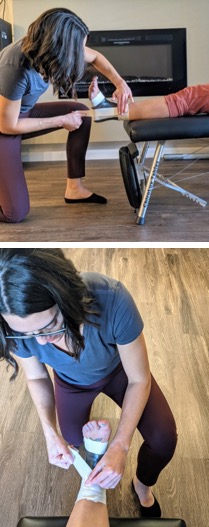By: Caitlin Jones, UWS doctor of chiropractic and sports medicine alumna

There are a few different master’s programs that are offered at UWS with sports medicine being the most popular one taken by doctor of chiropractic (DC) students. Throughout the first year, I went back and forth on whether or not I wanted to add it on and I talked to a number of students in the program to get a better idea of it. As with every program, there were some ideas of how it could be better, but the general consensus I received was that it was absolutely worth the extra work. So, when the time came, I applied and was ecstatic when I received my acceptance letter!
I really enjoyed the courses. I was able to take a new tidbit away from each class such as why you can get sick during intense exercise (hint: it’s the fastest way your body can get rid of excess hydrogen ions and balance your pH levels). The lectures are all online and there was a lot of reading assigned, but the in-person labs really helped to pull the information together. The Exercise Physiology lab the first quarter was great! Even though I’ve taken a Functional Movement Screen (FMS) course, it was great to run a few students through the screening and see it in action.
The practicum experience is the main reason why I enrolled in the sports med master’s program. Working with athletes at the high schools in the area as well as different events around Oregon such as Hood to Coast, volleyball tournaments, and a past student favorite – the rodeo – really stood out. Having the ability to work with a variety of different athletes on the sidelines of various sports is wonderful experience that I didn’t get in the Campus Health Center.
Since we were unable to work with teams in-person during the beginning of the pandemic, the professors really tried to make practicum a useful and informative experience. It became a choose-your-own-adventure and one could decide where your hours came from. One of the options was going through a SCAT 5, which is a concussion screening tool that we went over in a previous course. Performing this on a friend was still helpful because many teams conduct it at the beginning of a season to use as a baseline test. Having that experience also helped me when I was working with someone who was worried they had a mild concussion after hitting their head a couple days prior. Without having to look up anything, I was able to ask specific questions to help assess them and give them some things to look out for over the next few weeks.
Throughout the program, I was able to have more experience with extremities, history taking and working with scenarios where I could critically think about what diagnoses are most likely. Even though my practicum experience was very different than what I had imagined due to COVID, I’m still happy that I decided to take on the sports med master’s in addition to the DC program.
If you’re interested in the program and how it can help you in the field, I’d recommend reaching out to the alumni department so they can put you in touch with a graduate. To learn more about the admissions process and to apply to the program, check out all the information here!
